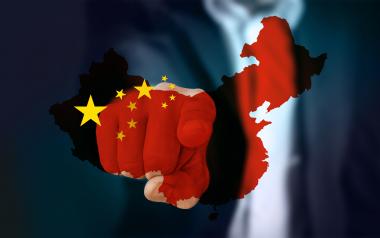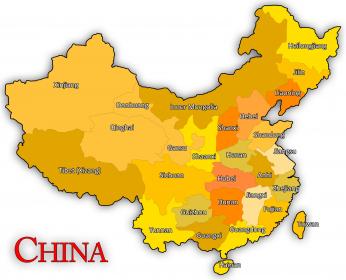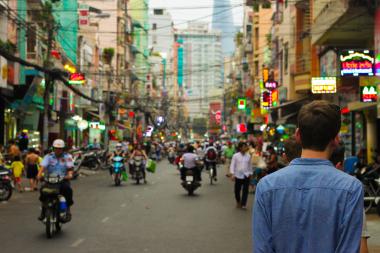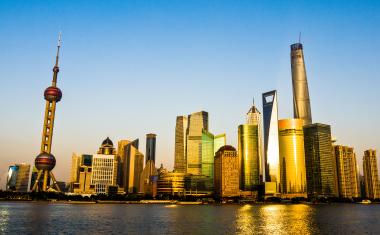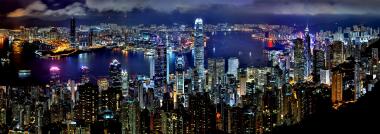FAIR MARKET CHINA
The People's Republic of China has experienced unprecedented economic growth since the late 1970s, with average double-digit growth rates. Over the past 10 years, the country has become the export world champion and holds the position as the second largest economy after the USA for almost as long. Along with the economic boom, modern China faces major challenges, including high wage increases, massive environmental problems and overcapacity in many industrial sectors.
Unlike at the beginning of the opening policy more than 40 years ago, when foreign investors with the appropriate technology and know-how were targeted, China is now pursuing a strategy to strengthen the domestic market. With the support of the "Made in China 2025" decree adopted in 2015, the Middle Kingdom is to become one of the leading industrial nations in three ten-year programs by 2045. In doing so, the government is focusing on promoting innovation, increasing production efficiency, optimizing the industrial structure and "green" production. Key sectors such as robotics, medical technology, electromobility and modern agricultural technology are defined as particularly eligible. The development of Industry 4.0 is also of great importance.
| GDP | USD 14,217 billion* |
| Population | 1,395.4 billion |
| Exports | USD 2,487.4 billion |
| Exports to Germany | EUR 106.3 billion |
| Imports | USA 2,135.6 Mrd. billion |
| Imports from Germany | EUR 93.1 billion |
Source: GTAI, Ministry of Foreign Affairs
China's regions have developed at different rates. Although the economically strong regions at the east and southeast coast of the country generate about half of the annual GDP, the areas in central and western China are recovering dynamically. With the "go-west" policy, since the turn of the millennium, the Chinese government has been increasingly working to promote and develop the western regions, increasing the attractiveness of the affected regions to foreign investment and business settlements.
Another ambitious project is designed for decades: The “One Belt and One Road” initiative, i.e. the revival of the "Silk Road", which connects more than 60 states in Asia and Europe via land and water. Planned and already implemented billion investment in the construction of ports, railways and telecommunications equipment. Opportunities for German companies exist above all for providers of special equipment in rail, shipping, port and aviation technology.
German-Chinese economic relations have developed very well in recent decades. At the beginning of 2014, the first Chinese Chamber of Commerce (CHKD) in Europe was founded in Berlin to promote the intensification of trade relations. Since 2011, Germany and China have been conducting regular government consultations that include comprehensive strategic partnerships.
In 2018, German exports to China amounted to EUR 93 billion. Imports from China today amount to more than EUR 100 billion. With a trade volume of about EUR 200 billion in 2018, Germany is by far China's most important European trading partner. For Germany, the People's Republic of China is again the most important trading partner in Asia and the third most important worldwide. The main products supplied to China are machinery, motor vehicles and automotive parts, electrical engineering and chemical products. Around 5,200 German companies are based in China; around 900 Chinese companies have settled in Germany.
Trade Fair Industry
Although China's economy is slowing, the world's second-largest economy continues to grow. Investments worth billions in infrastructure, housing, climate and environmental protection, combined with the construction and expansion of trade fair venues, have made China the most important trade fair venue in Asia, and this position is undisputed. Especially in cities such as Beijing and Shanghai, the professionalism of the trade fair organizers is high, above all because of the numerous international cooperation.
The fairs in Beijing, Shanghai and Guangzhou continue to characterize the Chinese fair landscape. Beijing as an important trade fair location is characterized by its proximity to political decision-makers and the extensive expansion of infrastructure. The majority of the major trade fairs take place in Shanghai and the concentration of international organizers is high.
The increased reorientation of the Chinese economy on the domestic market also influences the further development of the Chinese trade fair landscape, as the exhibition industry is increasingly turning to the service sector, digitization, automation, health, education and high-quality consumption.
The "New Silk Road" project also has a major influence on the Chinese trade fair industry: Chinese organizers are increasingly conducting trade fairs and trade fair participations in countries that are to be linked via the Silk Road. In 2018, 76 trade fair organizers were involved in 718 trade fairs in 33 countries, an increase of around 14% compared to the previous year. Most of the fairs were classified as multi-sector and machine-building exhibitions. With an increase of 19% compared to the previous year, the majority of the exhibition-related projects were realized in Russia.
| Country | Number of Fairs | Exhibitors from China |
| Russia | 132 | 3,870 |
| India | 89 | 3,129 |
| United Arab Emirates | 82 | 3,906 |
| Turkey | 30 | 1,728 |
| Thailand | 47 | 1,641 |
Since 2015, the Chinese State Council has been pursuing the strategy of making the domestic trade fair industry more international and transparent by 2020. For example, the approval of new trade fairs is to be gradually decentralized and responsibility transferred to the provinces. There is a noticeable professionalization of trade fairs outside the traditional trade fair locations of Beijing, Shanghai and Guangzhou. In addition, China has developed into the world's largest e-commerce market, i.e. online platforms are used as distribution channels for products. This development is also increasingly affecting trade fairs as a marketing instrument, as traditional aspects of trade fairs are virtualized.
The main problem for the Chinese trade fair industry remains the great complexity of the Chinese trade fair market with its many trade fair offerings, which vary greatly in terms of quality. In addition, the "Go West" strategy of the Chinese government to promote and develop the western regions has resulted in a large number of trade fair centers that are often not profitable due to their low capacity utilization. In 2018, for example, around 9.83 million m2 of exhibition space is said to have been available in 164 exhibition centers in China. More than half of the exhibition grounds had a utilization rate of less than 10%. The competition between trade fair locations for trade show themes and thus exhibitors and visitors lead to overlapping themes and schedules. Sufficient information or independently collected data on space utilization, exhibitor and visitor numbers are scarce and make it difficult for everyone involved to make the right trade fair selection.
Trade fair cities and exhibition venues
In China, many large exhibition centers have been built during the last 10 years. In 2018, 164 exhibition centers with a hall area capacity of 9.83 million m² were counted. That were 11 exhibition centers or 480,000 m² more than in 2017. Shanghai is the most important exhibition hub in the country - two of the largest exhibition centers are located here.
| Venue | Gross hall size in m² |
| National Exh. & Conv. Ctr (NECC), Shanghai | 400,000 |
| China Import & Export Fair Complex, Guangzhou | 338,000 |
| Kunming Dianchi Intern. Conv. & Exh. Centre | 300,000 |
| Western China International Expo City, Chengdu | 205,000 |
| Chongqing International Expo Centre | 200,000 |
| Shanghai New International Expo Centre (SNIEC) | 200,000 |
| Wuhan International Expo Centre | 150,000 |
| Nanchang Greenland International Expo Center | 140,000 |
| Xiamen International Conference & Exhibition Center | 140,000 |
| GD Modern International Exhibition Center, Houjie | 130,000 |
Additional fairgrounds were built over the last years e.g.in the provinces Shandong and Guangdong. With a covered exhibition area of 1.54 million m2 spread over 21 fair grounds the southern province Guangdong takes the top position in China.
German Engagement
In a comparison of countries, the People's Republic of China takes first place concerning German trade fair organizers’ self-organized events abroad. The concepts of these events are based on the standards of leading international trade fairs in Germany. Almost all major German trade fair organizers are active in China. By far the most attractive market is the economic metropolis of Shanghai.
Outside the leading trade fair cities of Shanghai, Beijing and Guangzhou, German organizers are active in Chengdu, Changsha, Foshan, Nanjing, Shenzhen, Wuhan, Qingdao and Xian.
| Year | Number GTQ** | China (without Hongkong) | Shanghai |
| 2019* | 324 | 86 | 51 |
| 2018 | 321 | 88 | 51 |
| 2017 | 300 | 83 | 50 |
| 2016 | 296 | 84 | 49 |
| 2015 | 295 | 84 | 49 |
* preliminary
**Self-organized events by German trade fair organizers are advertised by AUMA with the label "German Trade Fair Quality Abroad" (GTQ).
Source: AUMA database
Foeign Trade Fair Program
In the PRC, German companies can present themselves at numerous well-established trade fairs under the umbrella brand "made in Germany" within the Foreign Trade Fair Program. The trade fair participations in the form of German Pavilions cover a large part of the capital goods sector, such as mechanical engineering, food and packaging machinery, automotive supply industry, plumbing, heating, air conditioning, agricultural technology, health care to chemical and environmental engineering. But also, furniture, fashion and consumer goods fairs have been an important part of the program for many years. China is the most important trade fair venue for German companies within the Foreign Trade Fair Program, with Shanghai remaining by far the most important trade fair location.
Contacts
Delegation of German Industry and Commerce Beijing
E-Mail: info@bj.china.ahk.de
Homepage: http://www.china.ahk.de
Delegation of German Industry and Commerce Shanghai
E-Mail: office@sh.china.ahk.de
Homepage: http://www.china.ahk.de
Delegation of German Industry and Commerce Guangzhou
E-Mail: info@gz.china.ahk.de
Homepage: http://www.china.ahk.de
Embassy of the Federal Republic of Germany
E-Mail: embassy@peki.diplo.de
Homepage: http://www.peking.diplo.de
AUMA e.V.
Natalja Winges
Manager
Regions: Eastern Europe, Central and East Asia
Tel.: +49 30 24 000 124 Fax: +49 30 24 000 320
E-Mail: n.winges@auma.de
AUMA Association of the German Trade Fair Industry


